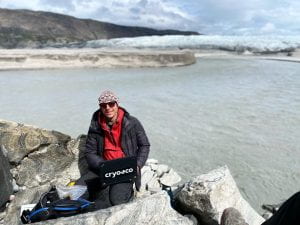
Dr Jakub Žárský of CryoEco installing a methane sensor and logger.
The Penn BiCycles Lab joined the CryoEco group from Charles University in Czechia for summer fieldwork as part of their MARCH4G project seeking to quantify the potential of the Greenland Ice Sheet bed to produce and release methane (CH4). Ice sheets likely overlie extensive, biologically active methanogenic wetlands. Previous work has hypothesized that basal environments (the region between the bottom of the ice and the solid bedrock) of ice sheets may produce and store large reservoirs of methane primed for export, if the hydrological conditions are right. During the summer melt period for the Greenland Ice Sheet (when temperatures are above freezing), meltwater generation and funneling through the ice sheet can act as a conduit for export and release of this methane to the atmosphere. Methane is a greenhouse gas with a warming potential 25-30x that of the equivalent amount of CO2, therefore more frequent or extensive flushing events during deglaciation could accelerate greenhouse climate warming and act as a positive feedback on deglaciation.
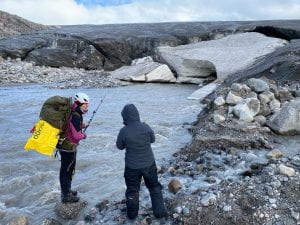
Anna Polášková and Dr Jade Hatton of CryoEco taking real-time methane measurements in air.
The Greenland Ice Sheet is the largest ice mass in the northern hemisphere and is rapidly retreating, losing mass at a rate of more than 300 billion tons per year. However, ice sheets have been ignored in the global methane budget and current data is insufficient to quantify the methane footprint of the Greenland Ice Sheet and other ice sheets. Recent research co-authored by Dr. Jon Hawkings (Lamarche-Gangnon et al., 2019 in Nature) found methane-rich meltwaters were exported from the Greenland Ice Sheet’s western margin during subglacial flushing events. This work highlighted the influence of melt on methane export from subglacial environments and suggested a need to include ice sheets in global methane budgets.
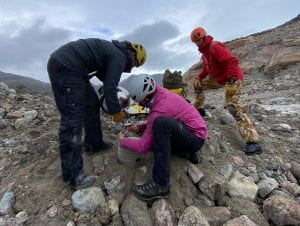
The team extracting methane from glacial meltwater.
This summer we joined the CryoEco group to help expand observations of methane export from the Greenland Ice Sheet to multiple meltwater rivers that drain the Western margin of the ice sheet. We took real-time field measurements of methane concentrations extracted from glacial meltwater immediately exiting the subglacial environment using a portable greenhouse gas analyzer. Further, we extracted and collected methane for radiocarbon and stable-isotope analyses back at the lab to determine the age and origin of the methane (e.g., abiotic vs. microbial). We also deployed novel methane sensors with battery-powered data loggers to collect time-series datasets (days to weeks) of dissolved methane concentrations in glacial meltwater. By deploying methane sensors both at the subglacial meltwater portal and downstream and coupling these data with additional water chemistry and flux data, we are able to examine both dissolved methane flux and rates of methane effusion to the atmosphere.
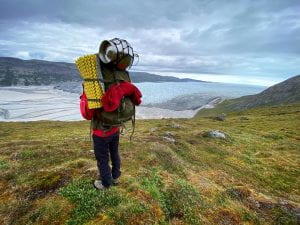
Dr Marek Stibal of CryoEco backpacking methane samples out from one of the sampling sites.
The BiCycles Lab role in the project was to measure chemistry of the meltwater (the “water quality”) to help figure out where the water has been prior to sampling. The chemistry of the water tells us a story about where the water has flowed, helping to inform the CryoEco team’s methane measurements. We collected and filtered (to remove particles) glacial meltwater at the front of each glacier that was sampled. This water will be analyzed in our labs at Penn for major ions (dissolved elemental/compound ions in water), trace metal, nutrient and mercury concentrations over the next few months. We’re also looking at a number of metal and metalloid stable isotope ratios, the organic molecules that are carried by meltwater, and the composition of sediments that give glacial meltwater its milky color.

Sampling for methane and water on top of the ice sheet. (Photo by Jakub Žárský)
These comprehensive biogeochemical datasets will allow us to better understand the origin of subglacial methane and how it might relate to other subglacial processes. Stay tuned for more from MARCH4G project, led by the CryoEco group in Prague, over the next few years. Their future work will include directly accessing the Greenland Ice Sheet basal ecosystem via hot-water drilling to retrieve subglacial sediment unaffected by contact with the atmosphere, experimental work to better understand biological CH4 cycling in subglacial environments, and biogeochemical modeling to constrain estimates of export from the Greenland Ice Sheet and its significance for the global CH4 budget. Exciting stuff! Follow along here and at CryoEco.eu for updates
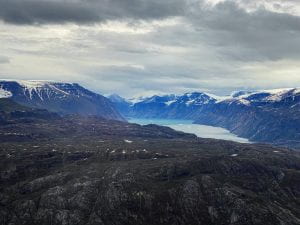
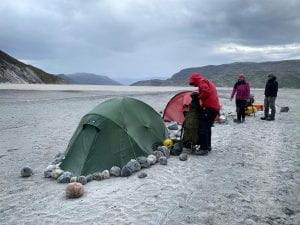
.
